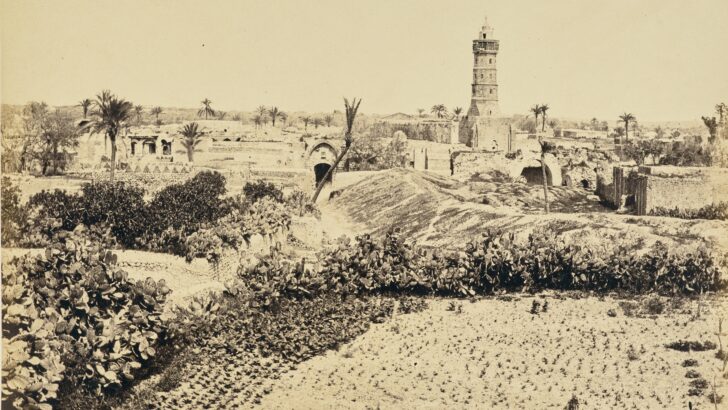Gaza, so much in the news recently, is one of the world’s oldest cities, though one might not believe this from what one reads or hears about it today in the media.
Gaza, which lies 50 miles or so south-south-west of Jerusalem, was in antiquity a great Philistine city and fortress, often mentioned in the Scriptures.
The original ancient city is thought by some scholars to have been at the mouth of the Wadi Guhzzeh, a site affected by malaria in season.
The site on Tell-el-Ajjul, was dug by the pioneering British archaeologist Flinders Petrie, who revealed that it had been occupied from the Neolithic stone through the Bronze Age.
But this was abandoned and the city moved to a place three miles from the sea. Here the trade routes from Egypt, Petra and Southern Arabia had their only practical route to the north from Egypt into Syria to Damascus and onwards Mesopotamia.
Classical
This was the route of frankincense and myrrh, for which there was an immense demand in ancient and classical times. The city was then a magnificent sight by all accounts, and was strongly fortified.
The oldest site in the city is the Tomb of St Porphyrius (347-420), who established Christianity in the city.
There is also what is traditionally said to be the tomb of Samson in the Abu al’Azm. His date is uncertain, but belongs to the period between the hero Joshua and the emergence of monarchy among the Jews; but like so many things in the early pages of the Bible his historicity is doubted by many scholars.
But he nevertheless remains a Jewish folk hero, ready to destroy himself in wiping out his enemies.
William Foxwell Albright, in his classic book From Stone Age to Christianity; Monotheism and the Historical process (first published in 1940 by Johns Hopkins Press, but later brought up to date in 1957) describes ancient Gaza in a chapter, ‘When Israel was a Child’ – that is to say, the original Israel.
Copies are readily available online; so though outdated in some respects, it remains an essential book, especially on how history and theology is constructed in the Middle East.
It is one of those books which reveal in detail just how complicated and involved the history of Palestinian region, as seen by the archaeologists and scientific historians.
But alas many who write and speak about the history of Palestine speak from what might be called, on all sides, ‘a prophetic point of view’.
This was the largest city in Palestine and Syria, eclipsing even Jerusalem. In the Bible it had figured prominently in the story of Sampson (Judges 16:3). It was seized by Alexander the Great 332 BC.
The crusaders in their turn built another fortress there in 1149, which resisted the advances of Saladin from Egypt until 1187. It was here that the Mamluks were finally overcome by the Turks who went on into Egypt and the Sudan.
The town, which lay about three miles from the coast, was captured by Napoleon, on his empire-creating expedition in his turn, in 1799.
But Napoleon was forced to retreat, and Egypt and Gaza came under British influence, eventuating in a protectorate of a sort which lasted down to Egypt gaining independence in 1922, after the dismemberment of the Ottoman Empire after the Great War.
There were two battles between the British and Turks under Allenby on his way north to Damascus.
But the modern town by about 1900 was the seat of a Greek Orthodox and of an Armenian bishop. It then had a population of a mere 10,000 or so people.
Prosperity
In the following decades Gaza returned to prosperity, partly due to its barley growing. The surrounding countryside was very fertile, and produced all kinds of fruits, pomegranates, oranges, dates and flowers. which were in great demand as far away as Constantinople.
By Victorian times there were some 500 looms at work producing cotton. The Arabs also produced large amounts of ashes used in soap making, though this was a declining industry due to the competition of imports from elsewhere.
Indeed Gaza in the eyes of one commentator in 1841 was little more than a large village. So it seemed there was the making of a truly prosperous community; but social and political turmoil since the 1950s have prevented an active local economy based on exports coming into existence and thriving.
At this time Gaza was a part of Palestine. With three centres Gaza, Khan Younis, and Rafah. This are now an essential part of the so-called ‘Gaza Strip’ which was created as a result of the armistice between Egypt and Israel in 1949 – it was the only part of the mandate left in Egyptian hands and the ceasefire.
But it was never made a part of Egypt. The Muslim hope then was that Gaza could be made the centre of a Palestinian State.
Though its maintenance suited the Egyptians, as it prevented Palestine refugees pouring down into Egypt, much as those who had moved across the river Jordan into Transjordan were maintained in ‘camps’, rather than settled.
However, between 1948 and the time of the Suez crisis it saw a great deal of fighting between Egypt and Israel. Israel drove the Egyptians out of Gaza and Sinai in November 1956.
The UN acted to restore the Gaza Strip to Egyptian administration, and this was the situation when the war of 1967 broke out, from which the present crisis derives.
So it seems that Gaza, an ancient city placed on important cultural crossroads, continues to see conflict. But its history demonstrates just how complicated and interconnected the peoples and cultures of the region are. Gaze deserves the peace it once had, back in the 1850s, but which has been denied to it since the 1950s.


 Peter Costello
Peter Costello Gaza in the late 1850s, photographed by the pioneering photographer Francis Frith
Gaza in the late 1850s, photographed by the pioneering photographer Francis Frith 